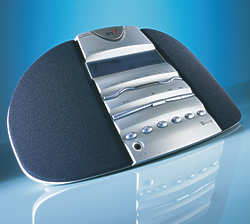Universal Audio, the manufacturer of authentic vintage analog reproductions and DSP-powered plug-ins, demonstrated its 2192 Dual Digital to Analog and Analog to Digital Converter at the NAMM Convention in Anaheim, California on January 16-19, 2003.
True to the company motto, Analog Ears; Digital Minds, the 2192 Dual DA/AD Converter is the first product to combine Universal Audio’s expertise in high-quality vintage analog gear with the advanced digital design technology it acquired with the recent purchase of software developer Kind of Loud Technologies.
The 2192, a single rack unit, provides simple front panel controls, supports sample rates up to 192K, and transcodes between AES/EBU, S/PDIF and ADAT in realtime, with single and dual wire AES modes. The 2192 is due to begin shipping in April 2003, retail price has not yet been announced.

“What really sets the 2192 apart from other DA/AD converters,” said Universal Audio VP of Engineering Joe Bryan, “is its Class-A analog circuitry, which has exceptional detail and image clarity, yet retains the warmth and character of the original source at all sample rates.”
The 2192 offers tremendous flexibility in signal routing and monitoring. For example, you can run signal into the analog inputs at sample rates ranging from 44.1K to 192K, and simultaneously output it to AES/EBU (single- or dual-wire), S/PDIF and ADAT (with industry standard S-MUX interleaving for sample rates above 48kHz). The selectable output monitor allows you to monitor any of the digital inputs, or the analog input with no interruption to the transcoding, making the 2192 an ideal hub in any personal or professional studio integrating the best of analog and digital technologies.
The 2192 also serves as an extremely high-quality digital to analog and analog to digital converter. As a front end for a native workstation, the 2192 provides two channels of sterling sound quality for tracking, monitoring and mastering. Or if you’re working on a digital console or workstation that utilizes higher sample rates, the 2192 will dramatically improve your monitoring environment and the quality of your analog masters.
 A virtually unknown UK-based company, Promotion & Display Technology (PDT) has done a great deal to build its international reputation with the launch of the first portable Internet radio, the InTune 200, at CES 2003 in Las Vegas.
A virtually unknown UK-based company, Promotion & Display Technology (PDT) has done a great deal to build its international reputation with the launch of the first portable Internet radio, the InTune 200, at CES 2003 in Las Vegas.